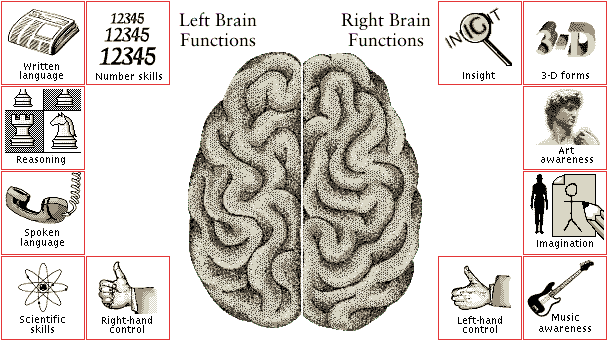This theory of the structure and functions of the mind suggests that the two different sides of the brain control two different "modes" of thinking. It also suggests that each of us prefers one mode over the other. Research has shown that the two different sides, or hemispheres, of the brain are responsible for different manners of thinking. The following table illustrates the differences between left-brain and right-brain thinking:
Most individuals have a distinct preference for one of these styles of thinking. Some, however, are more whole-brained and equally adept at both modes. In general, schools tend to favor left-brain modes of thinking, while downplaying the right-brain ones. Left-brain scholastic subjects focus on logical thinking, analysis, and accuracy. Right-brained subjects, on the other hand, focus on aesthetics, feeling, and creativity.
We'll keep this light and uncomplicated. Our brain, like the rest of our anatomy, is made up of two halves, a left brain a right brain. There's a big fold that goes from front to back in our brain, essentially dividing it into two distinct and separate parts. Well, almost separate. They are connected to each other by a thick cable of nerves at the base of each brain. This sole link between the two giant processors is called the corpus collosum. Think of it as an Ethernet cable or network connection between two incredibly fast and immensely powerful computer processors, each running different programs from the same input. The left side of our body is "wired" to the right side of our brain, and vice versa. For whatever reason nature did this cross-over, it applies even to our eyes, which process a majority of their sensory data on opposite sides of the brain.
Right-Brain vs. Left-Brain Thinking Impacts Learning. For curriculum: in order to be more "whole-brained" in their orientation, schools need to give equal weight to the arts, creativity, and the skills of imagination and synthesis. For instruction: to foster a more whole-brained scholastic experience, teachers should use instruction techniques that connect with both sides of the brain. They can increase their classroom's right-brain learning activities by incorporating more patterning, metaphors, analogies, role playing, visuals, and movement into their reading, calculation, and analytical activities. For assessment: for a more accurate whole-brained evaluation of student learning, educators must develop new forms of assessment that honor right-brained talents and skills.








